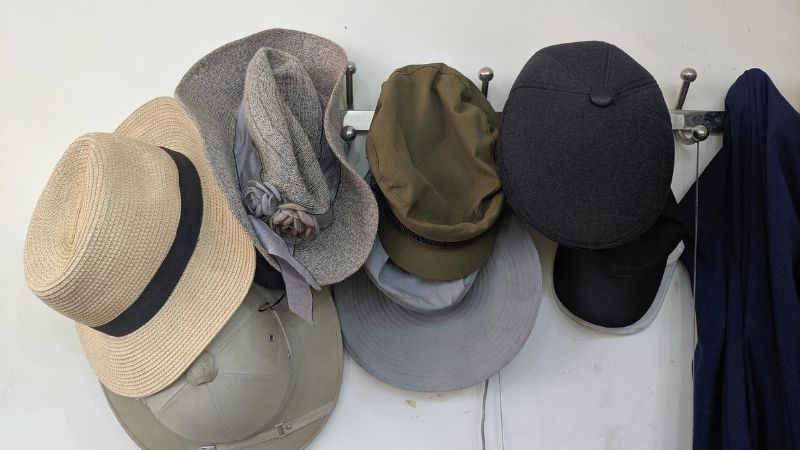Blog
How to Store and Care for Your Hat Collection
A well-curated hat collection can be a stylish and functional part of your wardrobe, but keeping your hats in excellent condition requires proper storage and maintenance. Whether you own a few classic fedoras, trendy beanies, or elegant wide-brimmed hats, knowing how to store and care for them will ensure that they last for years while maintaining their shape, cleanliness, and overall appeal. Here’s a comprehensive guide to help you store and care for your hat collection.

1. Cleaning Your Hats
Before you think about storing your hats, it’s important to clean them properly to ensure they stay in top condition.
Cleaning Methods for Different Types of Hats:
- Wool or Felt Hats:
Use a soft-bristled brush to gently remove dirt and dust from the surface. If there are stubborn stains, spot-clean them with a damp cloth. Avoid using harsh chemicals or soaking the hat in water, as it may damage the material. - Straw Hats:
Straw hats should be cleaned with a soft brush to remove any dirt. For stubborn stains, use a damp cloth with mild soap. Always let straw hats dry naturally in a well-ventilated area, away from direct heat sources. - Cotton or Fabric Hats:
These can often be machine washed, but always check the label for specific care instructions. If the label permits, wash them on a gentle cycle in cold water. For delicate fabric hats, hand washing with mild detergent is usually best. - Leather Hats:
Leather requires special care. Use a leather cleaner or conditioner to wipe down the surface and maintain its flexibility. Avoid soaking leather hats in water, and store them away from direct sunlight to prevent discoloration and cracking. - Baseball Caps:
These can often be cleaned in the washing machine (if the material allows it), but be sure to place them in a laundry bag to maintain their shape. For hand washing, use a soft brush and mild soap.
Drying Hats:
After cleaning, always air dry your hats in a well-ventilated space. Avoid using a dryer or placing them on a direct heat source, as this can warp or shrink the materials.
2. Properly Storing Your Hats
Once your hats are clean, proper storage is essential to preserving their shape, preventing damage, and ensuring they stay in top condition.
Storage Tips for Different Types of Hats:
- Hat Boxes:
One of the best ways to store hats, especially delicate ones like fedoras or wide-brimmed hats, is by using a hat box. These boxes are designed to keep the hats in their original shape, protecting them from dust, dirt, and accidental squashing. Choose a box with a sturdy design and breathable fabric lining to ensure proper air circulation. - Hat Stands or Racks:
For hats like fedoras, trilbies, and beanies, hat stands or racks are a great option. They allow your hats to maintain their shape while being easily accessible. Look for adjustable stands or racks that provide support for different hat sizes. These are especially useful for hats that you wear frequently. - Hanging Storage:
If you prefer hanging your hats, use a hat hook or a coat rack with rounded hooks to maintain their shape. Be sure not to hang them by the brim, as this could stretch the material. Instead, hang them by the crown or place them on a hanger to avoid distortion. - Use a Hat Form:
For floppy hats, wide-brimmed hats, or any hat with a soft crown, using a hat form (also known as a hat block) is an excellent way to preserve the shape. These can be found in various sizes to fit different styles and will keep your hats looking as good as new. - Avoid Storing Hats in Plastic Bags:
While it might seem like a good idea to protect hats from dust, storing them in plastic bags can cause the fabric to become musty and trap moisture. Instead, store your hats in a breathable fabric bag or a storage container with ventilation.
3. Storing Hats by Season
Storing hats properly according to the season can help prolong their life and make them easier to access when you need them.
For Summer Hats:
- Store Away from Direct Sunlight:
Straw and lightweight fabric hats should be stored in a cool, dry area away from direct sunlight, as prolonged exposure can cause fading and weakening of the fibers. - Breathable Containers:
Store summer hats in breathable fabric bags or boxes to prevent them from becoming dusty or losing their shape. Avoid overly tight packaging to allow air circulation.
For Winter Hats:
- Keep Them Clean and Dry:
Wool, felt, and knit hats can absorb moisture, so always ensure they’re dry and clean before storing them away for the season. - Store in a Cool, Dry Place:
Avoid humid areas, as excessive moisture can lead to mildew or mold growth. Store winter hats in a dry closet or drawer, with enough space to avoid crushing.
4. Maintaining the Shape of Your Hats
Maintaining the shape of your hats is essential, especially for hats with structured crowns or brims.
- Avoid Overcrowding:
Never stuff your hats into a drawer or closet where they’ll be squeezed or crushed. Overcrowding can cause permanent shape distortion. Give each hat plenty of room to breathe. - Use Tissue Paper or Padding:
If your hats are particularly floppy or large-brimmed, consider stuffing them with tissue paper or padding the inside with soft fabric to help retain their shape. For hats with a crown, a round object (like a ball or small pillow) inside can help preserve its structure. - Rotate Your Hats:
If you have multiple hats in your collection, rotate them regularly to avoid putting too much pressure on any one hat. Frequent use can cause wear and tear, so alternating between hats can help prolong their lifespan.
5. Preventing Common Hat Damage
To keep your hat collection looking fresh and vibrant, follow these tips to prevent common issues like wrinkles, fading, or misshaping.
- Avoid Rain and Moisture:
Whenever possible, try to avoid wearing your hats in the rain. If your hat does get wet, gently blot the moisture with a soft towel and reshape it while it dries. - Store in a Cool Area:
Extreme temperatures can cause damage to materials like straw, wool, and leather. Never store your hats in hot or damp areas, as heat can warp materials and humidity can lead to mold growth. - Keep Away from Pets and Children:
Hats can be easily damaged by pets or young children. Keep your collection in a designated area where they’re less likely to be handled roughly. - Protect the Brim:
Wide-brimmed hats or floppy hats can be vulnerable to crushing. If you need to stack hats, always make sure that the brims aren’t pressed against anything that could misshape them.
6. Repairing Your Hats
Even with the best care, accidents can happen, and sometimes your hats may need a little repair.
- Repairing a Felt Hat:
Small dents or wrinkles in a felt hat can usually be steamed out. Hold the hat over a pot of boiling water or use a steamer, and gently reshape it while it’s still warm. Be cautious not to over-steam, as this can cause the material to lose its form. - Fixing Frayed Brims:
For fabric hats with frayed or worn brims, try trimming the edges carefully with sharp scissors. If the fraying is severe, you may need to take the hat to a professional for re-shaping or re-sewing. - Cleaning Stains:
Small stains on your hats can often be cleaned with a mild detergent or spot cleaner. For stubborn stains, consider seeking professional cleaning services, especially for delicate or expensive hats.

Conclusion
Caring for your hat collection requires a bit of effort, but it’s worth it to keep your hats looking sharp and stylish. By cleaning your hats regularly, storing them properly, and taking care to preserve their shape, you can enjoy your hats for many years to come. Whether you’re storing them in hat boxes, on racks, or hanging them with care, remember that proper maintenance ensures your collection remains as impressive and fashionable as ever.


